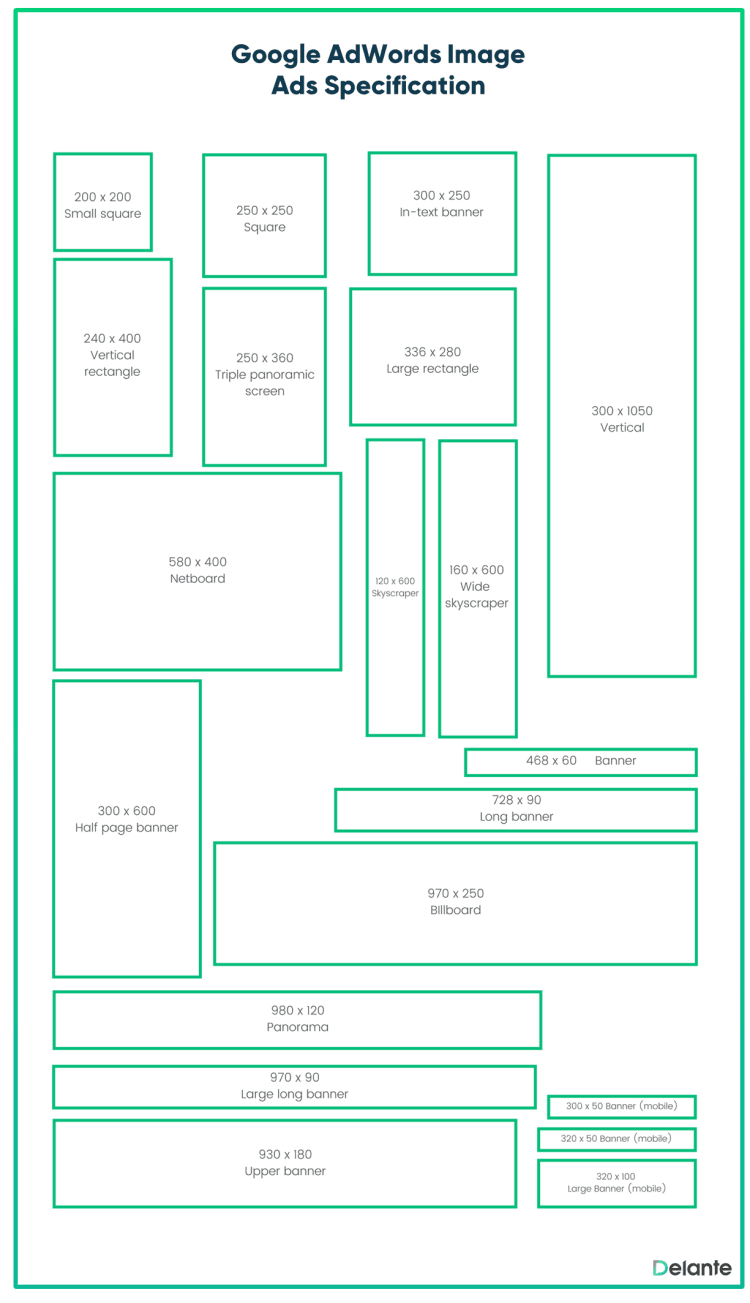Google Ads Image Specification

Looking for essential information about Google Ads image ads? In this post, you’ll find the most important info. We will discuss the basic technicalities, such as image sizes, content policy compliance and factors crucially impacting your campaign’s marketing efficiency.
Table of Contents:
- What A Google Image Ad Should Include?
- Things To Avoid While Creating An Image Ad
- Google Ad Sizes – Image Specification
- The most common image ad sizes
- Responsive Google Ads
- Information about the Google Image ads
- Dynamic Ads
- Gmail Ads
Maybe you’ve read our post “What Are Google Ads” – today we will take an even closer look and present specifications for Google image ads. The article you are about to read is supposed to serve as a cheat sheet for google ad sizes, a point of future reference anytime you’ll be preparing an image-based AdWords campaign. So remember to bookmark it! You can also share the article with the person directly responsible for creating the Google AdWords image ads campaign.
What a Google image ad should include
- Company logo. Each image ad should include a logotype. Instead of a standard logo copy-paste engineering or a simplified logo, it’s better to take time to come up with more inventive solutions. As an example of such innovation, imagine a banner showcasing a product with a logo on it, clearly exposed – e.g. in the case of a tech manufacturer, its mobile phone or laptop, a photo of a company’s office or trade fair stand, advertising tent or even a marketing gadget (t-shirt, business cards).
- Call to Action (a.k.a. CTA) To get the audience to convert, include a Call to Action in your banner, such as: “Visit our website”, “Check out the offer”, “order NOW!”, “call us”, “sign up for a newsletter”, etc. The best way to expose CTA is in the form of a button. Good CTA is good visually – catches. While contrasting colors seem an obvious choice, it’s not necessary, but the CTA button should nevertheless somehow stand out in the whole composition.
Example of our ad for polish market – CTA: “Order free quote” - USP (Unique Selling Point) – a unique benefit that the customer acquires, buying the product. USP should pervade our image ads, by being highlighted in its headings or description. Preparing several mockups, considering various USPs, is definitely a good idea.
- Product picture and price. Mandatory in any product advertising. If you’re running a Google AdWords Dynamic Remarketing campaign, these data will be extracted from Google Merchant Center. For a bargain, a dedicated banner showcasing the products on sale is a wonderful idea, too. A classic move here is showing the old price crossed out, or highlighting how much is the discount, or by what percentage the new price is lower than the old one.
- Sale info. Required for a good sale image ad: the bargain title, its duration, and other news you want to break to the potential customer. The image can also communicate a promo code, provided that it’s easy to memorize and that the ad is displayed frequently; otherwise, the campaign may trigger unexpected frustrated customer backlash due to the inability to write down or remember the code. Promo code from the banner or other ad should therefore be easily found on the landing page.
- Landing page referral. Ideally, the image ad and the landing page overview match. For the sake of this “dubbing” effect, the banner may copy the landing page layout, only with adjustments as to the size or text. Mind that any information included in the image ad needs to be easily found on the landing page.
We suggest preparing at least two different mockup image ad sets in order to run an A/B test. In the case of targeting a large group (over 10 000), the variations may differ in details only – e.g. color of the button. For smaller, albeit larger than 1 000 subjects, groups test only compositions significantly different from each other. In the case of targeting a group of fewer than 1 000 subjects, the sampling error is likely to render the findings statistically insignificant.
Optional compositional elements
- Figurative headline dubbing. Depending on the industry and the marketing strategy itself, there are a handful of guidelines for creating persuasive headlines. One of them says that the visual composition should refer to the content, for example: for a headline advertising sales increasing service, the visual layer shows e.g. mountains, and together with a headline exclaiming “success”, an icon of sports champion goes.
- The everlasting guidelines are also the following: golden ratio, tripartite composition division, laws – Hick’s and Fitt’s and Occam’s Razor. These are also some additional elements to learn about, which is strongly recommended if you want to keep improving your compositions.
Things to avoid while creating an image ad
- Word count overkill or unreadable content. Mind the fonts – some of them are hard to read, is they’re too small or appear too fuzzy. On the other hand, if you include too much text content, your image ads may be disapproved by Google. Put a strong focus on the headlines and the Call to Action instead. Don’t let the total amount of space occupied by text exceed 20%-30% of the entire image area.
- No landing page referral. Bounce rate spikes, whenever the landing page visually strongly differs from a layout they saw in a banner they decided to click on. As the bounce rate gets high, the marketing effectiveness of our landing page drops, along with the effectiveness of your image ad campaign.
- Low-quality design. “Fine feathers make fine birds” – this proverb sums up the take-home-message behind numerous guidelines for image ad creation. Google image ad creation should stick to the most up-to-date internet visual trends. Therefore, if you cannot afford a visual artist, think about using responsive or text ads only, instead. Mind that the main goal of an image ad campaign is to build brand awareness.
- Bad visual targeting. “Jack of all trades is a master of none” – another proverb in today’s guide, reminding that even for the most popular FMCG products, defining the target group for our communication is a must. Personalization significantly increases the effectiveness of our activities.
Image ad will be disapproved if:
- The content is misleading.
- The image quality is poor.
- Its relevance is too low.
- Promotes NSFW content.
- Promotes harmful products.
Google Ad Sizes – Image Specification
Supported ad specifications
File types
- Formats: GIF, JPG, PNG, SWF, ZIP
- Maximum size – 150 KB
An image should be a file of one of the formats above, with a maximum weight of 150KB (mind that it’s also a limit for html5 files).
Google Ads sizes
Supported sizes illustration:
Google supports the following image ad dimensions and sizes
Square and rectangular
200 × 200 Small square
240 × 400 Vertical rectangle
250 × 250 Square
250 × 360 Triple panoramic screen
300 × 250 In-text banner
336 × 280 Large rectangle
580 × 400 Netboard
Skyscraper
120 × 600 Skyscraper
160 × 600 Wide skyscraper
300 × 600 Half page banner
300 × 1050 Vertical
Long banner
468 × 60 Banner
728 × 90 Long banner
930 × 180 Upper banner
970 × 90 Large long banner
970 × 250 Billboard
980 × 120 Panorama
For mobile devices
300 × 50 Mobile banner
320 × 50 Mobile banner
320 × 100 Large banner for mobile devices
The most common image ad sizes
The following are the most popular ad dimensions. Preparing a mockup set of ads tailored to many of the sizes below is recommended, as the preparation for all formats available is usually challenging.
Desktop
250 x 250
200 x 200
468 x 60
728 x 90
300 x 250
336 x 280
120 x 600
160 x 600
300 x 600
970 x 90
Mobile
320 x 50
200 x 200
250 x 250
300 x 250|
320 x 100
Instructing our visual artist, remember to let them know that you’d like your project adaptable to all formats. Avoid commissioning the preparation of 10 different mockups with only one adaptable to the aforementioned supported formats. Before launching the campaign, review all the formats and how it looks on various devices.
Google Image Ads are really great when you want to make sure your promotion reach a specific target audience. To make the campaign efficient remember about adding a proper amount of image dimensions. In Delante, we suggest using at least 10 of them. It’ll be the base of your campaign, but remember – the more pictures you give Google to choose from, the more places your ad will reach.

Responsive Google Ads
Ads’ responsiveness is automatic adjusting of size, appearance, and format. You need to create only one template based on the following specification, filling it with image and text content, and all the size/format variants are then generated automatically. To create such an original, you need to submit:
- Horizontal rectangle visual: required aspect ratio is 1.91: 1, the minimum size is 600 x 314 (recommended size: 1200 x 628). The maximum file size is 1 MB.
- Square: 1: 1 required aspect ratio and the minimum size of 300 x 300 (recommended size: 1200 x 1200). The maximum file size is 1 MB.
- Logo: 1:1 required aspect ratio and a minimum size of 128 x 128 (recommended size: 1200 x 1200). The logo can also come as a rectangle with a 4: 1 aspect ratio of a minimum size of 512 x 128 (recommended size: 1200 x 300). The logo must be centered. The maximum file size is 1 MB.
The most common way to go is to prepare a single visual, which is then adjusted to the appropriate size. Should that be the case, remember to position the text with the most important information in such a way as to enable all the cropping required.
If you don’t have your client’s own specific visuals, download from their website or go for industry-specific licensed stock photos (see the example below).
Only for the sake of presentation clarity, an image with too much text was picked. That is a stock licensed photo there.
Information about the Google Image ads
- Headline: maximum 25 characters
- Second headline: 90 characters max. Try to fit all the most important information there. If y?You don’t need to use all characters available for it – don’t. The second headline can be short.
- Ad text: up to 90 characters. Just as with the second header, you do not need to use all the characters available. Your text may end up cropped, it’s marked by an ellipsis then.
- Business name.
- Final URL
Dynamic ads (including Dynamic Remarketing)
- Dynamic Display Ads with images: for a dynamic marketing campaign you may use templates from Google – then there’s no need to create additional visuals. Currently, Google AdWords offers 14 free templates for your own advertising activities. For the ads to display correctly, a configured GMC account and a correctly uploaded product data feed are required.
- There’s also a Dynamic responsive ad beta version available – it feeds product information directly from the Google Merchant Center product data file, just like Dynamic Display Ads do, but with automatic ad format adjustments. The ad template displays text ads, too – it uses the short headline form for this purpose. The long headline and a description line look just like in the responsive ads.
- Last, but not least – however, the least common type of ads – are Dynamic Shopping text Ads.
Benefits of Dynamic Display Ads:
- Time-efficiency. With a GMC Product Feed extracted, it only takes the template configuration to launch a campaign. The visuals themselves can be tailored to our vision in an instant.
- Intelligence. Dynamic ads respond accordingly to the user behavior (remarketing) as well as changing website context.
- Control over the campaign.
Ads in HTML5
The specifications for HTML5 ads are the same as for image ads. However, there are some additional guidelines for HTML5 ad format:
- No external resources references are allowed.
- Only a single ZIP file is allowed – all the required files need to comprise that single archive.
- No loops are allowed; animation can last up to 30s long.
- Use the dedicated Google HTML5 Validator before making an attempt to run a campaign with your file!
Gmail Ads
Gmail Ads appear upon choosing responsive ads. For Gmail ads using one of the templates or submitting your own, fitting the specifications, is available. For the templates available, the specification is as follows:
- Logo: minimum size 144 x 144 pixels, maximum size: 150 KB, 1: 1 aspect ratio,
- Business name: up to 20 characters,
- Headline: up to 25 characters; may be an offer, information about the percentage of discount or some other interesting info,
- Text: up to 90 characters; may contain a short product description or a convincing Call to Action,
- Display URL: up to 255 characters,
- Final URL: no character limit.
Image ad template
- Image (submitted): [300-650 px] x [300-1000 pixels],
- Supported image formats: JPEG, JPG, PNG, GIF (not animated),
- Maximum image size: 1 MB.
MIND THE EVIDENCE – we suggest preparing at least two different mockup image ad sets in order to run an A/B test.
Keep In Mind
.. that Google image ads are but one way of available visual customer communication channels. Before the campaign brief is laid out, specify:
- The goal. Specify the campaign goals. In addition to brand awareness and sales increases, you can specify micro-conversion goals such as time spent on the website, user engagement or CPM.
- The target group. You will communicate with students differently than you will with customers interested in apartments for sale.
- The campaign schedule. Mind all the delays – i.e. time needed for corrections and the time needed to have your campaign approved by Google. Specify the end date of your campaign. Mind the holidays and events. Also, remember to refresh the permanent campaign elements – we recommend doing that on a quarterly basis.
- Campaign budget. Outline the expected campaign spendings.
- Whether you want to use the extensions. Google offers call extensions and business location extensions.








Nice article. I have a question – should I somehow work with images that I put into the content (such as landing pages, blog posts, etc.) so that they work for my website performance? Up until now I just added them, end of story but I heard that they can support SEO as well, so how to do it?
Nice Article. I have a question about the aspect ratio of the images. Where Can I set it if i’m doing it through their API and not directly in the browser?